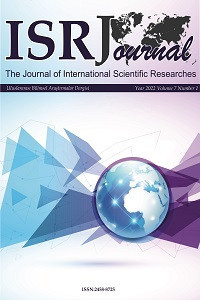Lider Üye Etkileşiminin Bir Öncülü Olarak Bağlanma Stilleri
Bağlanma biçimleri, Kaçınan bağlanma, Güvenli bağlanma, Korkulu bağlanma, Lider üye etkileşimi
Attachment Styles as An Antecedent of Leader-Member Interaction
Attachment styles, Dismissing attachment, Secure attachment, Fearful attachment, Leader-member exchange,
___
- Ainsworth, M. S., & Bowlby, J. (1991). An ethological approach to personality development. American Psychologist, 46(4), 333.
- Bartholomew, K., & Shaver, P. R. (1998). Methods of assessing adult attachment. In J. A. Simpson & W. S. Rholes (Eds.),Attachment theory and close relationships (pp. 25-45). New York: Guilford.
- Bauer, T. N., & Green, S. G. (1996). Development of leader-member exchange: A longitudinal test. Academy of management journal, 39(6), 1538-1567.
- Berant, E., & Obegi, J. H. (2009). Attachment-informed psychotherapy research with adults. Attachment theory and research in clinical work with adults, 461-489.
- Berson, Y., Dan, O., & Yammarino, F. J. (2006). Attachment style and individual differences in leadership perceptions and emergence. The journal of social psychology, 146(2), 165-182.
- Boatwright, K. J., Lopez, F. G., Sauer, E. M., VanDerWege, A., & Huber, D. M. (2010). The influence of adult attachment styles on workers' preferences for relational leadership behaviors. The Psychologist-Manager Journal, 13(1), 1-14.
- Bolat, O. İ. (2011). Lider üye etkileşimi ve tükenmişlik ilişkisi. İş, Güç Endüstri İlişkileri ve İnsan Kaynakları Dergisi, 13(2), 63-80.
- Bowlby, J. (1969). Attachment. Attachment and loss, (Vol 1). New York: Basic Books.
- Bowlby, J. (1973). Separation: anxiety and anger. Attachment and loss, Vol(2). New York: Basic Books.
- Bowlby, J. (1980). Loss: Sadness and depression. Attachment and loss, Vol (3). New York: Basic Books.
- Bowlby, J. (1982). Attachment and loss: retrospect and prospect. American journal of Orthopsychiatry, 52(4), 664.
- Brown, L. S., & Wright, J. (2001). Attachment theory in adolescence and its relevance to developmental psychopathology. Clinical Psychology & Psychotherapy: An International Journal of Theory & Practice, 8(1), 15-32.
- Brown, E. D., & Wright, G. D. (2016). Antibacterial drug discovery in the resistance era. Nature, 529(7586), 336-343.
- Büyüköztürk, Ş. (2002). Faktör analizi: Temel kavramlar ve ölçek geliştirmede kullanımı. Kuram ve uygulamada eğitim yönetimi, 32(32), 470-483.
- ISSN: 2458-8725
- Yayın Aralığı: Yılda 3 Sayı
- Başlangıç: 2016
- Yayıncı: Salih YILDIZ
Hazır Giyim Sektöründe Marka Tercihlerinin Markov Zincirleriyle Öngörülmesi
Yeliz ŞAFAK, Vedat SAĞLAM, Murat SAĞIR
Türkiye’deki Toplum Eczacılarının Yönetim Becerilerinin Değerlendirilmesi
Ronayi COŞKUN, Muammer ÇALIKUŞU, Gülbin ÖZÇELİKAY
Melani RİSTESKA, Hatun BOZTEPE TAŞKIRAN
İşyerinde Haset ile Yaşam Doyumu Arasındaki İlişkide Bilgi Paylaşımının Düzenleyici Rolü
Veri Zarflama Analizi ile Enerji Şirketlerinin Etkinlik Değerlendirmesi
Lider Üye Etkileşiminin Bir Öncülü Olarak Bağlanma Stilleri
21. Yüzyılda STEM Eğitiminin Gelişimi ve Küresel Önemi
Türkiye’de Risk Yönetimi Bağlamında Afete Hazırlıkla İlgili Yazılan Lisansüstü Tezlerin İncelemesi
